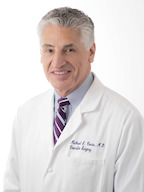Visceral Artery Aneurysm
UCSF vascular surgeons have extensive experience in treating complex aortic aneurysms, including those involving the arteries to the kidneys or intestines, and have been pioneers in the field of endovascular aneurysm repair. Our faculty also serve as principal investigators in clinical trials of promising new endovascular devices to treat aneurysms.
A visceral artery aneurysm is a ballooning of a section of the splenic, renal, hepatic or mesenteric arteries. These arteries supply blood to the visceral organs - the spleen, kidney, liver and intestines, respectively.
Aneurysms occur from the weakening and thinning of the artery wall. When a part of the arterial wall swells and stretches to more than 150 percent of its original diameter, this is called an aneurysm.
Aneurysms discovered prior to rupture must be measured, closely monitored and evaluated for treatment. Small visceral artery aneurysms — less than two centimeters in diameter — are sometimes monitored periodically to check for growth.
Signs and Symptoms
The symptoms of a visceral artery aneurysm vary with the affected artery. Aneurysms associated with the renal artery may disrupt kidney function, for example, leading to high blood pressure (renovascular hypertension). The greatest threat posed by an aneurysm is rupture. Symptoms may include:
- Severe pain
- Internal bleeding
- A sudden drop in blood pressure
A ruptured aneurysm is a medical emergency that requires immediate treatment.
Diagnosis
Most visceral artery aneurysms are diagnosed with an ultrasound or CT scan. These studies measure the diameter of the aneurysm — a key element in determining the optimal treatment. Others are found during a diagnostic imaging study, e.g. ultrasound, X-ray or MRI ordered to evaluate another condition, a so-called "incidental finding".
Treatment
The risk of rupture is greatest when a visceral artery aneurysm measures more than two centimeters in diameter, or is rapidly increasing in size. Small aneurysms should be monitored. Blood pressure medication may help to slow the rate of enlargement of an intact aneurysm. While surgical repair of the artery is the only definitive cure, the risk of rupture must be weighed against the risks of surgery and any pre-existing conditions in the patient.
Open Surgical Repair
In an open surgical repair, the surgeon makes an incision in the abdomen, removes the distended (swollen) portion of the artery, and replaces it with a segment of the patient's vein, or with a synthetic tube called a graft.
Endovascular Repair
Some visceral artery aneurysms can be embolized, or filled with particulate material that causes the diseased segment of the artery to fill with clot (thrombus). Other visceral artery aneurysms can be treated with a stent graft. This is a metallic mesh tube with a fabric covering; the dilated segment of the artery is lined with the stent graft, effectively fixing the artery from the inside. Both of these procedures are performed via catheters inserted, under local anesthesia, through small punctures into the artery in the groin. The catheter is then advanced, under X-ray guidance, into the diseased visceral artery.
Endovascular repair is not an option for all visceral artery aneurysms. The arterial anatomy of the patient must be compatible with the endovascular therapy and the surgery is technically challenging. UCSF vascular surgeons have extensive experience in treating complex aneurysms involving the arteries to the kidneys or intestines, and serve as a regional referral center for the most difficult cases.










